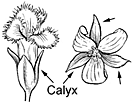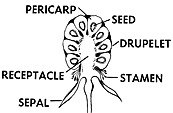Kamani
Calophyllum inophyllum
Alexandrian Laurel family (Calophyllaceae)
Polynesian introduction
This handsome tree found along or near seashores is identified by cream-colored resinous sap or latex in bark, paired thick and stiff, elliptical shiny dark green leaves with closely spaced parallel veins, white flowers clustered among leaves, and round ball 1–1 1⁄2 inches (2.5–4 ) in diameter. Apparently introduced by the early Hawaiians, rather than native.

Forest And Kim Starr
Leaves in four vertical rows on twigs, hairless, with light green leaf-stalks 5⁄8–3⁄4 inch (1.5–2 ) long, stout and flattened above. Blades elliptical, 4–8 inches (10–20 ) long and 2 1⁄2–3 1⁄2 inches (6–9 ) wide, slightly notched at rounded rounded at base, slightly turned up from yellow green and concave, with narrow whitish line along straight border; thick and stiff, with numerous very fine straight parallel side veins scarcely visible until dried, upper surface shiny dark green, lower surface yellow green and slightly shiny.
Flower clusters () 2–6 inches (5–15 ) long at leaf base, with 4–15 fragrant white flowers about 1 inch (25 ) across on long stout stalks to 1 1⁄2 inches (4 ). of four rounded concave white 1⁄4–3⁄8 inch (6–10 ) long, in two pairs; of 4–8 elliptical to oblong concave spreading petals 1⁄2–5⁄8 inch (13–15 ) long; many about 5⁄16 inch (8 ) long, with orange and white filaments slightly united at base; and with round red single-celled containing one ovule, slightly curved and
() few in clusters, round balls, light green, becoming yellow or brown, with thin pulp. Seed single, large, brown, round, 3⁄4–1 1⁄4 inches (2–3 ) in diameter, including shell and kernel.
The sapwood is white and heartwood reddish brown. When fresh cut, the heartwood is distinctly white and red. The wood has a pronounced figure on tangential faces imparted by parenchyma tissue and interlocked grain. It is of moderate density ( gr. 0:6), with a relatively large shrinkage in drying which can result in considerable warping of lumber. It is subject to tear-outs in machining due to its grain, but turns well except for a peculiar tendency to snag chisels. It is not resistant to decay or termites and is currently used in Hawaii only occasionally for carved and turned craftwood products. Elsewhere, it is used for general construction, cabinetmaking, boat-building, railroad crossties, and similar purposes. Hawaiians made bowls from the wood. The doors of the main floor of Iolani Palace in Honolulu have panels of kamani veneer.
The aromatic latex or resin has served in folk remedies and as tacamahaca resin of commerce.
The thick dark green oil extracted from the seeds has been employed medicinally. Formerly, it was used as ointment for skin and hair and for burning in lamps. Reportedly, the seeds are poisonous.
Regarded as sacred, this tree was grown around temples in the South Sea Islands. Planted in the tropics as an ornamental or shade tree for the dense shiny dark green foliage and fragrant flowers. The species is slow growing. It is a common street tree in Puerto Rico and has been introduced into southern Florida.
Large groves occur near the coasts through the Hawaiian Islands. One in Halawa Valley, Molokai, was noted by early explorers and apparently has been replaced by younger trees. This species is utilized as an ornamental along coasts because of its resistance to salt spray. It is planted along Dillingham Boulevard, near the Dole Pineapple Cannery, along Kailua Road, along Lunalilo Home Road at Koko Marina, and many other places on Oahu as a street tree. Particularly common between Isaac Hale Beach Park and Opihikao in the Puna District of Hawaii.
Special areas
Waimea Arboretum, Iolani
Champion
Height 59 ft (18.0 ), c.b.h. 18.5 inches (5.6 ), spread 81 ft (24.7 ). Malama-ki Forest Reserve, Puna, Hawaii (1968).
Range
Native of East Indian region of southeast Asia and Pacific islands but widely planted through the tropics.
Other common names
kamanu, Alexandrian-laurel, beautyleaf; daog (Guam, N. Marianas); btaches (Palau); biyuch (Yap); rakich (Truk); isou (Pohnpei); eet (Kosrae); lueg (Marshalls); fetau (Am. Samoa)
True kamani sometimes has been confused with an introduced tree of shores, false kamani or tropicalalmond, Terminalia catappa, with which it is usually planted. The two species are rather distinctive in leaf size, leaf color, and general appearance. A large kamani tree with a name tag grows in Iolani Palace grounds near the gazebo (bandstand). Next to it is a false kamani, also labeled.







